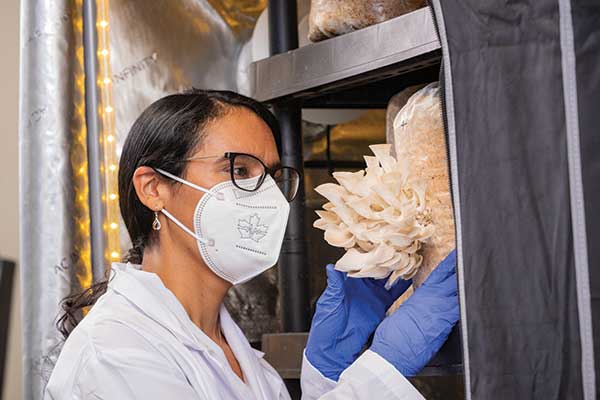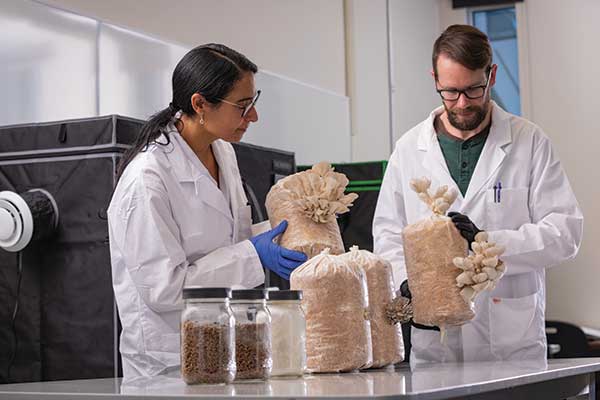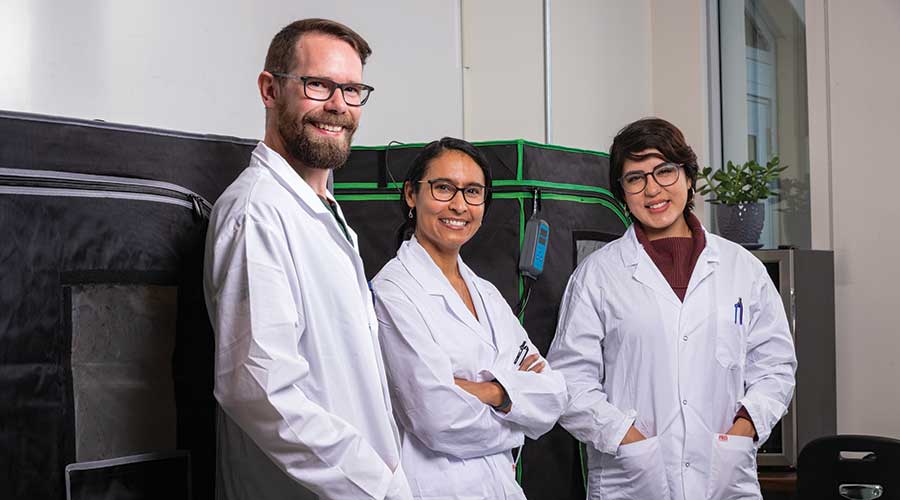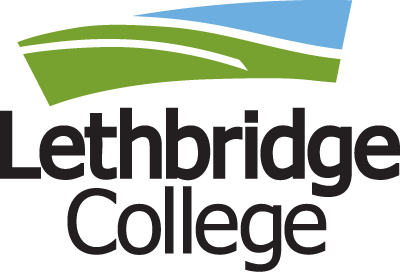
Dr. Adriana Morrell really likes mushrooms. We’re talking a turned-a-backyard-hobby-into-a-funded-research-project level of liking mushrooms.
And, if you take a visit to her mycology lab at Lethbridge College, you’ll quickly see why these fabulous fungi have captured her attention. Inside a small room tucked away in the Cousins building sit a pair of unassuming black tents that, when unzipped, reveal shelves of mushrooms bursting out of their bags, boasting shapes and colours that almost seem other-worldly.
These aren’t your grocery-store mushrooms. These mushrooms – blue and pink oyster, lion’s mane and shiitake to name a few – are being grown using various types of food waste as part of Morrell’s research to test the viability of sustainable substrates. Once they’re harvested, the mushrooms land in the frying pans of the college’s Culinary students to be shared with the campus community.
Morrell is an Environmental Sciences instructor who received an internal research grant through the college’s Centre for Applied Research Internal Fund to create a mycology lab on campus last summer. Her research focuses on the benefits of both medicinal and gourmet fungi, while promoting sustainability in agriculture by testing the use of food wastes as a growing substrate compared to more common and cost prohibitive substrates. Morrell’s research is looking at how food waste can not only replace them, but how they can also add nutrients and benefits to the mushrooms.
“These are things that mushroom producers are keen on learning because it could mean more yield and faster production – maybe you’ll get bigger mushrooms, lighter cups or better pigmentation,” says Morrell, who has already seen the results of coffee grounds producing a stronger hue in blue oyster mushrooms, something that can go a long way in the desirability of a mushroom when sitting on a shelf in a grocery store.

Currently, the project is testing and comparing three pairs of substrates against each other: wheat straw versus hemp straw, gypsum versus pulverized eggshells, and spent brewers’ grain versus used coffee grounds.
“It’s a constant battle to reduce waste in our personal lives, so of course we want to try and recover as much waste as possible through this research,” says Morrell, who is providing the spent brewers’ grain from her and her husband’s home brewing operation. The used coffee grounds come straight from the college’s Food Court.
When harvested, Morrell personally delivers boxes of fresh mushrooms straight from her lab to the Culinary kitchens, creating an accessible and sustainable way for students to work with the rare and unique produce.
“What we’re trying to do is show people that there are other mushrooms beyond the usual kinds we see in the grocery store,” explains Morrell. “They taste amazing, but they are different. They have a different shape, they have a different colour and typically people tend to stay away from what looks different from what we know. For me, the most exciting part is bringing that unknown piece to people and allowing them to try it in a better way.”
Having fresh mushrooms growing on campus means huge cost savings for the Culinary program. Not only does it eliminate transportation costs, but it also preserves the delicate fungi through the reduction of packaging and long-term storage.
“It’s beneficial anytime our school can produce a product that we can put directly into the hands of our students, not only on the business side – but it’s even better when it’s tied into applied research,” says Chef Doug Overes (Professional Cooking 1987, Distinguished Alumnus 1992), chair of the college’s Culinary Careers program. “The biggest benefit is when a student can see that farm to table, locally grown concept in action. It gives them a sense of pride to be able to say, ‘this is ours; this is Lethbridge College.’”
Additionally, Morrell’s mushrooms give Culinary instructors an opportunity to take students out of the kitchens for a tour to see how the mushrooms are grown and the processes involved. Understanding where your food comes is something Overes says is incredibly important, especially for those who are preparing it.
As Morrell’s research continues, she is already looking to future topics including the benefits of fungi in a variety of use-cases such as mycorrhizal fungi, which support root systems for plants to transfer nutrients and water they couldn’t access alone. This type of research could assist in environmental reclamation projects in grasslands and contaminated sites.
And, the next time you find yourself staring at packages of mushrooms at the grocery store, try something that looks a little different. You might be surprised to find you, like Morrell, really do like mushrooms.

RECIPE
Adriana Morrell’s Creamy Mushroom Pasta
INGREDIENTS
- 5 tbsp. ........................... extra-virgin olive oil
- 1.5 lbs. ........................... oyster mushrooms chopped into bite-size pieces (cremini or shiitake may also be used)
- 1 ............................. medium red bell pepper, diced
- 1 ........................... clove of garlic, minced
- ⅓ c. .............................. finely chopped fresh parsley
- 2 tsp. ............................ fresh sweet basil
- 1 lb. .............................. spaghetti
- ⅓ c. ............................. milk or cream
- 2 tbsp. ........................... butter
- 1 tbsp. ......................... all-purpose flour
- ½ c. ............................ Parmesan or Asiago, finely grated, plus more for serving
- To taste ......................... Salt and freshly ground pepper
METHOD
- Heat 3 tbsp. olive oil in a large pot over high heat. Add the oyster mushrooms and toss occasionally, adding more olive oil as needed. Cook until edges start to brown, about four to five minutes. Sprinkle mushrooms salt and pepper as they cook.
- Reduce heat to medium-high. Add red bell pepper and toss until they are brown and start to crisp on the edges. Add the garlic, parsley and basil, stirring often, about two more minutes. Set pot aside.
- Meanwhile, cook pasta in a large pot of boiling salted water, stirring occasionally, until al-dente, about two minutes less than package directions. Drain the pasta and set aside with the lid on.
- In a small saucepan, melt the butter and add the flour as soon as the butter starts sizzling. Stir quickly, just for a few seconds. Do not overcook. Slowly add the milk. Reduce heat to medium-low and constantly stir to incorporate the milk into the butter mixture. As soon as the sauce starts to thicken, remove it from the heat and add it to the mushroom pot.
- Using tongs, transfer pasta to the pot with mushrooms and sauce. Place back on the stove, at medium-high heat, tossing constantly, until pasta is a bit softer, but still al-dente, and sauce has thickened, about three to four minutes.
- Remove pot from heat. Add cheese, fresh parsley and pepper to taste, and toss to combine. Taste and season with salt, if needed. Divide pasta among bowls and top with more Parmesan if desired. Enjoy!



